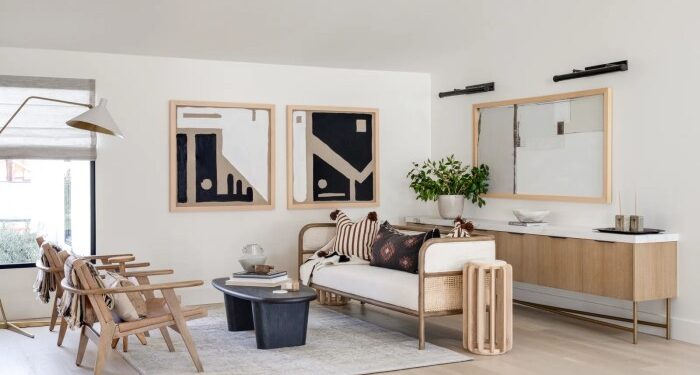Scandinavian interior design sets the stage for this enthralling narrative, offering readers a glimpse into a story that is rich in detail and brimming with originality from the outset. The clean lines, minimalist approach, and emphasis on functionality are just a few aspects that make this design style truly captivating.
Let's delve into the world of Scandinavian interiors and uncover the beauty and simplicity that define this timeless aesthetic.
.
Characteristics of Scandinavian Interior Design
Scandinavian interior design is known for its simplicity, functionality, and minimalism. It focuses on creating a cozy and inviting atmosphere while emphasizing clean lines and a clutter-free aesthetic.Color Palette in Scandinavian Interiors
The color palette in Scandinavian interiors typically revolves around whites, soft neutrals, and light pastel shades. These colors help to reflect natural light and create a sense of spaciousness in the room.Importance of Natural Light
Natural light plays a crucial role in Scandinavian design as it enhances the overall brightness and warmth of the space. Large windows are common in Scandinavian interiors to allow ample light to enter the room throughout the day.Popular Materials in Scandinavian Interior Design
Wood Light woods such as pine, birch, and oak are commonly used in Scandinavian interiors to add warmth and texture. Metal Stainless steel, brass, and copper accents are often incorporated to provide a touch of modernity and contrast. Textiles Soft textiles like wool, cotton, and linen are used for furniture upholstery, rugs, and curtains to add coziness and comfort to the space.Furniture and Decor Elements in Scandinavian Design
Scandinavian interior design is known for its minimalist approach to furniture and decor elements, creating spaces that are functional, stylish, and inviting. Let's delve into the key aspects of furniture and decor elements in Scandinavian design.Minimalist Approach to Furniture
In Scandinavian interiors, furniture is often characterized by clean lines, simplicity, and functionality. Pieces are typically understated and sleek, with a focus on quality craftsmanship and natural materials like wood. The goal is to create a sense of spaciousness and airiness in the room, allowing the furniture to blend seamlessly with the overall design aesthetic.Functional and Stylish Storage Solutions
Storage is a crucial element in Scandinavian design, as it helps maintain the clutter-free look that is synonymous with this style. Furniture pieces like sleek cabinets, modular shelving units, and multi-functional pieces with hidden storage compartments are commonly used. These solutions not only provide ample storage space but also contribute to the overall aesthetic appeal of the space.Role of Textiles in Adding Warmth
Textiles play a significant role in adding warmth and coziness to Scandinavian spaces. Rugs, throws, and cushions in soft, natural materials like wool and cotton are used to create a sense of comfort and hygge. These textiles also bring texture and visual interest to the room, enhancing the overall ambiance and making the space feel more inviting.Common Decorative Elements
In addition to furniture and textiles, common decorative elements in Scandinavian interiors include plants and artwork. Plants bring a touch of nature indoors, adding freshness and a pop of color to the space. Artwork, whether in the form of prints, paintings, or sculptures, adds personality and character to the room, reflecting the homeowner's style and interests.Layout and Spatial Arrangement in Scandinavian Interiors
In Scandinavian interior design, the layout and spatial arrangement play a crucial role in creating a sense of openness, harmony, and coziness within a space.Emphasis on Open Floor Plans
Scandinavian design often features open floor plans that seamlessly connect different areas of the home. This design approach allows for better flow of natural light, promotes a sense of spaciousness, and encourages social interaction among residents and guestsConcept of Hygge and its Influence
The Danish concept of hygge, which embodies coziness, comfort, and a feeling of well-being, heavily influences the layout of Scandinavian spaces. It emphasizes creating intimate and inviting environments where people can relax and unwind. This leads to the use of warm lighting, soft textiles, and natural materials to enhance the overall sense of hygge in a room.Furniture Placement Contribution
Furniture placement in Scandinavian interiors is carefully thought out to maximize functionality and visual appeal. It often focuses on creating a balanced layout that allows for easy movement and accessibility while also enhancing the overall aesthetic of the space. The use of multipurpose furniture and minimalistic design elements further contribute to the clean and uncluttered look of Scandinavian interiors.Tips for Creating Balance and Harmony
To achieve a sense of balance and harmony in a Scandinavian-inspired room, consider the following tips:- Opt for a neutral color palette with pops of muted tones to create a calming atmosphere.
- Integrate natural elements like wood, stone, and plants to bring a sense of the outdoors inside.
- Focus on creating cozy nooks with soft textures and warm lighting to promote relaxation.
- Avoid clutter by prioritizing storage solutions and keeping the space organized and uncluttered.
- Experiment with different furniture layouts to find the most functional and visually appealing arrangement for your space.
Sustainability and Eco-Friendliness in Scandinavian Design
Scandinavian design is not only known for its minimalistic and functional aesthetic but also for its strong focus on sustainability and eco-friendliness. The design philosophy of "less is more" extends beyond aesthetics to include a commitment to using environmentally friendly materials and practices.Integration of Natural Materials and Sustainability Principles
Scandinavian interiors often feature natural materials such as wood, stone, and leather, which are not only aesthetically pleasing but also sustainable choices. These materials are sourced responsibly, often locally, to reduce the carbon footprint associated with transportation.Examples of Eco-Friendly Practices in Scandinavian Homes
- Use of energy-efficient lighting fixtures and appliances to reduce electricity consumption.
- Incorporation of recycling and composting systems to minimize waste production.
- Preference for vintage or second-hand furniture to promote reuse and reduce consumption.
- Integration of indoor plants for improved air quality and a connection to nature.
















